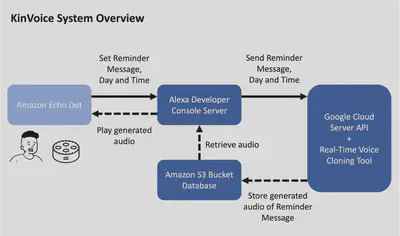
Overview
With voice user interfaces (VUIs) becoming ubiquitous and speech synthesis technology maturing, it is possible to synthesise AI voices that resemble our friends and relatives, which we will collectively call ‘kin’, and use them on VUIs. However, designing such interfaces and investigating how the familiarity of kin voices affect user perceptions remain under-explored.
Check out the video overview:
Role and Results
I led this research:
- Created the concept
- Interface and custom API development
- Conducted user studies
- Writing and publication to CSCW 2021 (journal article)
Assistance in development: Tamil Selvan Gunasekaran
KinVoice System Implementation

As an example application, we implemented a prototype, KinVoice, on Amazon Echo Dot devices that enables users to set reminders and receive. It issues the reminders in AI-generated voices based on the voices of family members and friends.

Key Findings
User Perception
- The voices of friends and family promoted the feeling of connection (co-presence), social presence and telepresence.
- The voices were persuasive, credible, and charismatic.
- The voices were likeable, safe, and eerie (drew attention to the interface).

